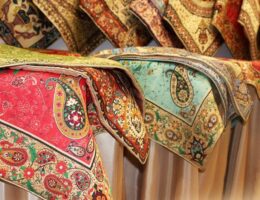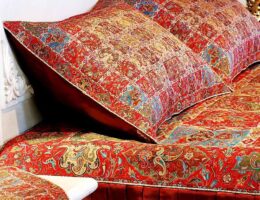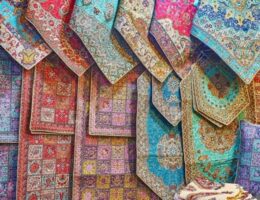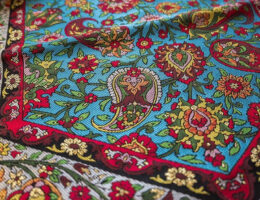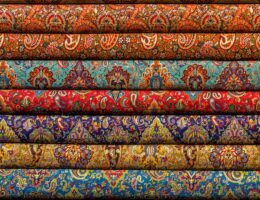IRAN ART EXHIBITION: KILIM HANDICRAFT IS A PERFECT ART BETWEEN OTHERS
It would indeed be hard to dispute the Iranian claim to have produced the most elaborate, the most decorative, the most valuable, and the ,most superbly assured carpets, which are considered as our cultural exports in the world. Because of the lack of furniture in most Iranian houses, particularly in rural areas, carpets are far more than just floor coverings. It is still partly true to say that Iranians, Particularly in villages, display their wealth on the floor and- because the most valuable carpets are certainly not for walking over- on the wall.
The fascinating floral designs of the Persian carpets consistently recall the fabled and wonderful landscapes and versatility of the Persian gardens. Thus, it can be said: ‘’He, who takes such a carpet home, will be in possession of a miniature Persian garden indeed.’’ The most ancient carpets known to exist are those found nearly three decades ago at Kizirik in southeastern Siberia. The design and weft of these carpets, which have been preserved in exceptionally good condition show that they belong to the Achaemenian period.
The secret of the magnificence of the Persian carpet lies in the choice of material the richness of the blonds of colors, the beauty of the design and the fine quality of the craftsmanship Except for silk carpets, wool is used as the basic material in the making of most Persian carpets. Carpet weavers have an overwhelming preference for wool cut from the living sheep, from the neck and stomach, believing that such wool preserves a freshness and shine,
Certain regional characteristics. However, do stand out clearly. Towards the end of pre- Islamic period. Stylized animal and human figures began to turn up on some carpets. After the Arab conquest , Koranic verses were incorporated into some carpet designs, and prayer rugs began to be produced on a grand scale; secular carpets too became a major industry and were highly prized in European courts. The finest carpets produced before the middle of the sixteenth century came from Tabriz, and modern Tabriz rugs still show similarities of wool and weaving. Kashan produced the most opulent carpets, unrivaled for sumptuous material and brilliance of color. Esfahan is famous for its ingenuity in the composition of the highly ornamental characteristic of design and kerman for the simplicity of its decoration and the silky softness of its materials.
To the subject matter of Persian carpets there is no limit. Animals abounded in the great ‘’hunting’’ carpets of the golden age. ‘’garden’’ carpets portray trim flowering shrubs Birds nest everywhere. And are freely used for decorative purpose in tribal carpets of every period. Altogether, the dominant note is stylized floral ornament: lotus flowers and rosettes, leaf palmettos, arabesques of blossom, saying vines, and so- called cloud bands (imported from China in the late 15th century).
It must be said that carpets of superlative quality and good colors. As well as the interesting and attractive rugs produced within the last hundred years or so are fairly readily available; among them characteristically Qajar designs from Tehran and Tabriz: passable Kashans and Hamadans; Turkamans, Afghans, Baluchis and so- called Bokharas galore, rosette designs from Varamin.
IRAN ART EXHIBITION: Just as beautiful as the carpets, the varieties of kilims (tribal cotton weave) and summaks are widely woven in great profusion and variety by women and young girls all over Iran, many with good peasant designs, much appreciated by the western travelers, unlike carpet weavers who work from a fixed pattern, the kilim weavers produce the attractive geometrical designs from memory, and in exactly the same way as the tapestries of Europe. The weft serves to make the pattern and to bind the fabric together. It is drawn across the warp only as far as the particular color is required ; it never goes across the entire rug. The weft threads are beaten so close that the warp threads become virtually invisible. This is similar to the process used in piled carpets to achieve the tight closely packed knots.
The raw materials for a kilim, depending on the quality, usually consist of wool and cotton and dyes. As with piled carpets the best quality wool for kilims are the hard and lustrous wool from the backs of the Iranian sheep rather than the fine merino wool developed for clothing. Most kilims contain a mixture of wool and cotton, and the better quality kilims have an increasingly higher proportion of wool.
The glorious and sometimes primitive color of the Iranian kilims was originally derived from a simple range of natural dyes and long tradition of skillful management. Colors are achieved by successive dipping in baths of the primaries. Kilims are produced throughout Iran, particularly in the tribal regions of Fars, Kermanshahan, Kurdestan, Azarbaijan and Khorassan. Kilim making in all these province is one of the oldest crafts.
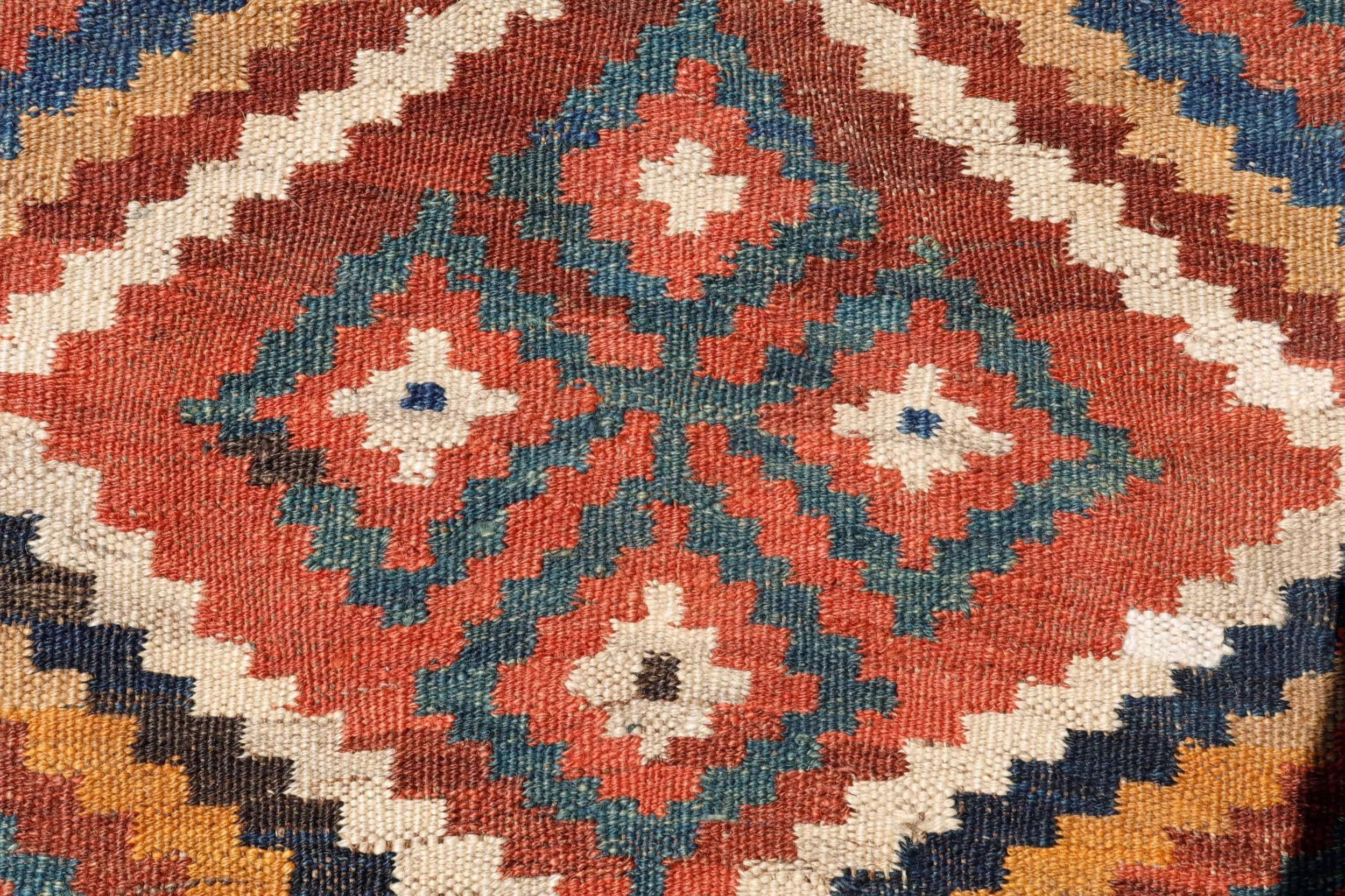
How Iranian Carpets are Made
The wool of the sheep is shorn by hand, then washed in a particular manner to take off dirt and fat. After drying and classifying, it is carded and then spun. In recent years several washing, dyeing and spinning machines suitable to Persian carpet weaving techniques, have been introduced.
The wool is treated with vegetable and animal dyeing material. In each district there exist special methods and formulas for dyeing the wool. After dyeing, the wool is washed in clear water and hanged to dry vegetable dyes are obtained from madder- root, walnut peels, grape leaves, esparak (spurge) straw, dyers, weed, weed, pomegranate peels and gall nut, Animal dyes come from cochineal, acidulated milk, qaraguroot, etc Minerals and chemicals are also used in conjunction with dyeing formula such as caustic soda, citric acid, Hydrosulphide and Alum. These chemical are required to make the dye fast and prevent the color s from washing away.
The designer draws the pattern on pieces of paper pasted side by side to make one quarter of the area of the carpet. The design is colored and handed over to the operator who places it before him in front of the loom and used such wool in this weaving that matches exactly with the colors in the drawing.
Two methods are used in weaving Persian carpet: the Turkish and the Farsi (Persian) knots. In the Turkish method knots are tied with the help of a hooked needle. The Farsi method uses no needle; knots are tied entirely by hand.
The carpets of the Turkish method are more durable in texture because of system of knots in the warp, but the texture on the back of the carpet does not look as even as that of the carpet of the Farsi method. The Farsi carpet, for reason of a different method of knots tied in the warp, has an even and nice- looking back. The back of these carpets shows itself fine and smooth. Thought the number of knots made in every square inch may be the same as that in the Turkish method.
IRAN ART EXHIBITION: The loom of classic rugs, namely the ones made in towns are erected vertically and stand in front of the operator, while the looms of tribal rugs such as Baluch and Turkman are set horizontally. The looms of the tribal rugs are smaller compared to with those used in other areas, which are more classic in structure.
A loom is basically a frame of wood on which the warp threads are stretched tightly between the upper and lower crossbeams. The warp consist of threads lying close together (the finer the carpet the closer and thinner the threads) and running the length of the loom. Onto these warp threads is knotted the woolen yarn which forms the pile of the rug. When one row of knots is completed across the width of the carpet, a weft thread (of cotton mainly) is inserted down against the knots as firmly as possible to give the knots and the fabric strength and firmness. The process is repeated row after row until the pile of the carpet is completed. Then following the last part of the operation, namely the shearing of the pile which has to be trimmed to the desired length for a thick mass of woolen threads is still hanging on the front. The tighter and closer a pile in knotted. The shorter it can be cut. Close knotting has the advantage that the outline of the design shows clearly and is not hazy. It has the precision of a painting. But loose and coarse knotting gives indistinct and vague contours.
The knotting must be even and regular for the design to show clearly, if one looks at the back of a well- knotted carpet the designs and colors stand out clearly and the more exact and sharply defined this pattern appears the better the carpet has been worked. In the machine- woven carpets, the pattern appears only very hazily. This is a sure sign that is has not been hand knotted.

